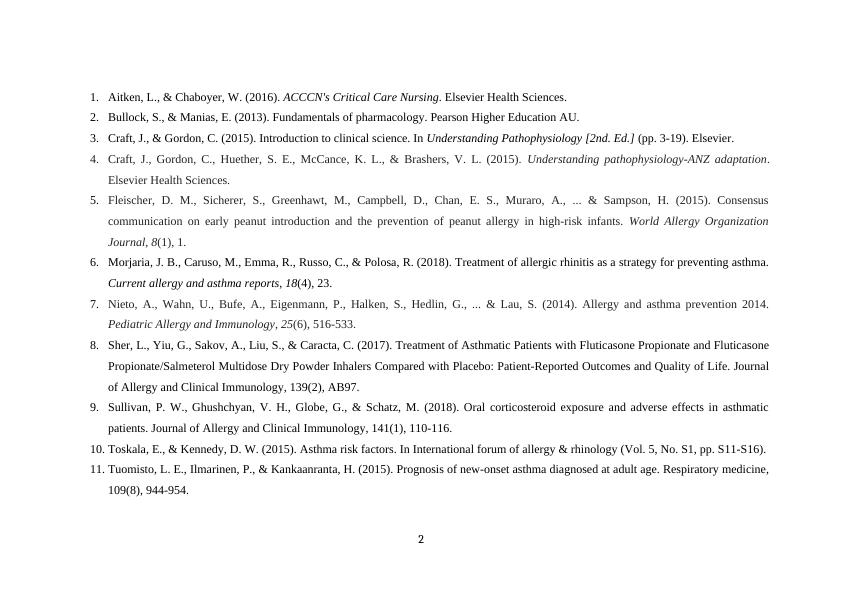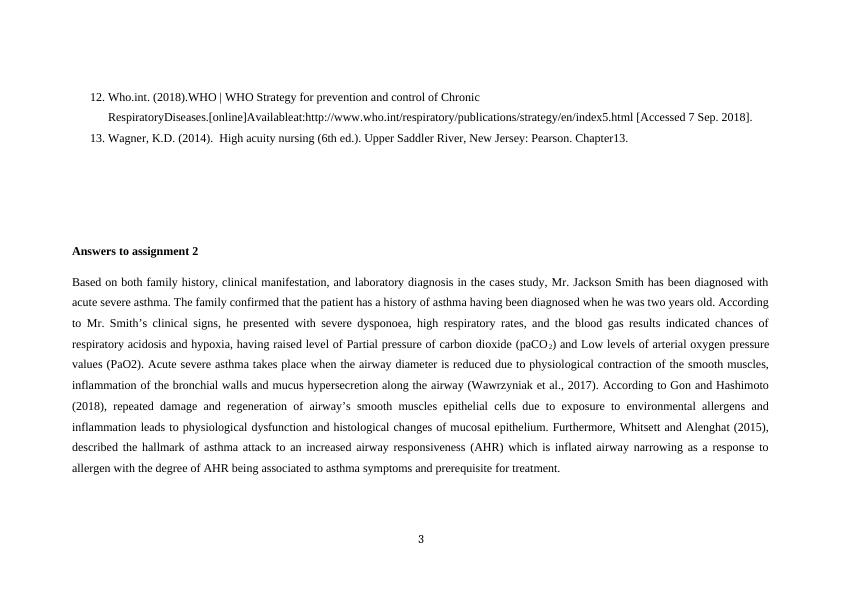Pathogenesis and Treatment of Acute Severe Asthma
Added on 2023-06-07
9 Pages3225 Words337 Views
1
Asthma
Results inCause
Prognosis
The risk of death in asthmatic person is higher to
approximately twice that in other person.
13, 14
Asthma is a chronic inflammatory disease of the airways
that causes airway hyperresponsiveness, mucosal edema,
and mucus production. 1, 3, 14
Course of disease
Atopic asthma-eczema
Non atopic asthma
1, 3
Secondary prevention
Allergen-specific
immunotherapy
Control of environmental
allergens. 7,14
Evaluation
Access the airway
Assess and evaluate
changes in vital signs
obstruction
1, 3
Nursing Interventions
Obtain a history of allergic reactions
to medication
Assess the patient’s respiratory
status by monitoring the severity of
symptoms
1, 7,14, 15
Pharmacologic Therapy
Short- acting beta 2-agonist-
salbutamol
Long-acting beta 2 agonist-
satmeterol
Inhaled corticosteroid-
beclomethasone 2,6,11,14
Tre
atm
ent
Primary prevention
Avoidance of personal exposure to
common risk factors
Avoidance of direct and indirect
exposure to tobacco smoke
12, 14
Diagnosis
Complete family history
Acute wheeze and tachypnoea
Triad of cough and breathlessness
1, 14, 15,
Clinical features
Coughing
Dyspnea
Wheezing
Shortness of breath
Risk factors
Family history
Allergies
Occupational exposure
Obesity
Smoking 12,14
Pathogenesis
Activation when the mast cells are activated, it releases several mediators
These mediators perpetuate the inflammatory response, causing
increased blood flow, vasoconstriction, and fluid leak from the
vasculature, attraction of white blood cells to the area
Progression increased mucus production, decreases the ability to bring air
into the alveoli low oxygenation red blood cells are able to exchange.
Aetiology
Acute bronchoconstriction due to
allergens results from a release of
mediators from mast cells that
directly contract the airway. 1, 14,
Leads to
need for
immedia
Diagnoses
1, 4, 6, 13, 14
1, 3.12
5
Asthma
Results inCause
Prognosis
The risk of death in asthmatic person is higher to
approximately twice that in other person.
13, 14
Asthma is a chronic inflammatory disease of the airways
that causes airway hyperresponsiveness, mucosal edema,
and mucus production. 1, 3, 14
Course of disease
Atopic asthma-eczema
Non atopic asthma
1, 3
Secondary prevention
Allergen-specific
immunotherapy
Control of environmental
allergens. 7,14
Evaluation
Access the airway
Assess and evaluate
changes in vital signs
obstruction
1, 3
Nursing Interventions
Obtain a history of allergic reactions
to medication
Assess the patient’s respiratory
status by monitoring the severity of
symptoms
1, 7,14, 15
Pharmacologic Therapy
Short- acting beta 2-agonist-
salbutamol
Long-acting beta 2 agonist-
satmeterol
Inhaled corticosteroid-
beclomethasone 2,6,11,14
Tre
atm
ent
Primary prevention
Avoidance of personal exposure to
common risk factors
Avoidance of direct and indirect
exposure to tobacco smoke
12, 14
Diagnosis
Complete family history
Acute wheeze and tachypnoea
Triad of cough and breathlessness
1, 14, 15,
Clinical features
Coughing
Dyspnea
Wheezing
Shortness of breath
Risk factors
Family history
Allergies
Occupational exposure
Obesity
Smoking 12,14
Pathogenesis
Activation when the mast cells are activated, it releases several mediators
These mediators perpetuate the inflammatory response, causing
increased blood flow, vasoconstriction, and fluid leak from the
vasculature, attraction of white blood cells to the area
Progression increased mucus production, decreases the ability to bring air
into the alveoli low oxygenation red blood cells are able to exchange.
Aetiology
Acute bronchoconstriction due to
allergens results from a release of
mediators from mast cells that
directly contract the airway. 1, 14,
Leads to
need for
immedia
Diagnoses
1, 4, 6, 13, 14
1, 3.12
5

1. Aitken, L., & Chaboyer, W. (2016). ACCCN's Critical Care Nursing. Elsevier Health Sciences.
2. Bullock, S., & Manias, E. (2013). Fundamentals of pharmacology. Pearson Higher Education AU.
3. Craft, J., & Gordon, C. (2015). Introduction to clinical science. In Understanding Pathophysiology [2nd. Ed.] (pp. 3-19). Elsevier.
4. Craft, J., Gordon, C., Huether, S. E., McCance, K. L., & Brashers, V. L. (2015). Understanding pathophysiology-ANZ adaptation.
Elsevier Health Sciences.
5. Fleischer, D. M., Sicherer, S., Greenhawt, M., Campbell, D., Chan, E. S., Muraro, A., ... & Sampson, H. (2015). Consensus
communication on early peanut introduction and the prevention of peanut allergy in high-risk infants. World Allergy Organization
Journal, 8(1), 1.
6. Morjaria, J. B., Caruso, M., Emma, R., Russo, C., & Polosa, R. (2018). Treatment of allergic rhinitis as a strategy for preventing asthma.
Current allergy and asthma reports, 18(4), 23.
7. Nieto, A., Wahn, U., Bufe, A., Eigenmann, P., Halken, S., Hedlin, G., ... & Lau, S. (2014). Allergy and asthma prevention 2014.
Pediatric Allergy and Immunology, 25(6), 516-533.
8. Sher, L., Yiu, G., Sakov, A., Liu, S., & Caracta, C. (2017). Treatment of Asthmatic Patients with Fluticasone Propionate and Fluticasone
Propionate/Salmeterol Multidose Dry Powder Inhalers Compared with Placebo: Patient-Reported Outcomes and Quality of Life. Journal
of Allergy and Clinical Immunology, 139(2), AB97.
9. Sullivan, P. W., Ghushchyan, V. H., Globe, G., & Schatz, M. (2018). Oral corticosteroid exposure and adverse effects in asthmatic
patients. Journal of Allergy and Clinical Immunology, 141(1), 110-116.
10. Toskala, E., & Kennedy, D. W. (2015). Asthma risk factors. In International forum of allergy & rhinology (Vol. 5, No. S1, pp. S11-S16).
11. Tuomisto, L. E., Ilmarinen, P., & Kankaanranta, H. (2015). Prognosis of new-onset asthma diagnosed at adult age. Respiratory medicine,
109(8), 944-954.
2
2. Bullock, S., & Manias, E. (2013). Fundamentals of pharmacology. Pearson Higher Education AU.
3. Craft, J., & Gordon, C. (2015). Introduction to clinical science. In Understanding Pathophysiology [2nd. Ed.] (pp. 3-19). Elsevier.
4. Craft, J., Gordon, C., Huether, S. E., McCance, K. L., & Brashers, V. L. (2015). Understanding pathophysiology-ANZ adaptation.
Elsevier Health Sciences.
5. Fleischer, D. M., Sicherer, S., Greenhawt, M., Campbell, D., Chan, E. S., Muraro, A., ... & Sampson, H. (2015). Consensus
communication on early peanut introduction and the prevention of peanut allergy in high-risk infants. World Allergy Organization
Journal, 8(1), 1.
6. Morjaria, J. B., Caruso, M., Emma, R., Russo, C., & Polosa, R. (2018). Treatment of allergic rhinitis as a strategy for preventing asthma.
Current allergy and asthma reports, 18(4), 23.
7. Nieto, A., Wahn, U., Bufe, A., Eigenmann, P., Halken, S., Hedlin, G., ... & Lau, S. (2014). Allergy and asthma prevention 2014.
Pediatric Allergy and Immunology, 25(6), 516-533.
8. Sher, L., Yiu, G., Sakov, A., Liu, S., & Caracta, C. (2017). Treatment of Asthmatic Patients with Fluticasone Propionate and Fluticasone
Propionate/Salmeterol Multidose Dry Powder Inhalers Compared with Placebo: Patient-Reported Outcomes and Quality of Life. Journal
of Allergy and Clinical Immunology, 139(2), AB97.
9. Sullivan, P. W., Ghushchyan, V. H., Globe, G., & Schatz, M. (2018). Oral corticosteroid exposure and adverse effects in asthmatic
patients. Journal of Allergy and Clinical Immunology, 141(1), 110-116.
10. Toskala, E., & Kennedy, D. W. (2015). Asthma risk factors. In International forum of allergy & rhinology (Vol. 5, No. S1, pp. S11-S16).
11. Tuomisto, L. E., Ilmarinen, P., & Kankaanranta, H. (2015). Prognosis of new-onset asthma diagnosed at adult age. Respiratory medicine,
109(8), 944-954.
2

12. Who.int. (2018).WHO | WHO Strategy for prevention and control of Chronic
RespiratoryDiseases.[online]Availableat:http://www.who.int/respiratory/publications/strategy/en/index5.html [Accessed 7 Sep. 2018].
13. Wagner, K.D. (2014). High acuity nursing (6th ed.). Upper Saddler River, New Jersey: Pearson. Chapter13.
Answers to assignment 2
Based on both family history, clinical manifestation, and laboratory diagnosis in the cases study, Mr. Jackson Smith has been diagnosed with
acute severe asthma. The family confirmed that the patient has a history of asthma having been diagnosed when he was two years old. According
to Mr. Smith’s clinical signs, he presented with severe dysponoea, high respiratory rates, and the blood gas results indicated chances of
respiratory acidosis and hypoxia, having raised level of Partial pressure of carbon dioxide (paCO2) and Low levels of arterial oxygen pressure
values (PaO2). Acute severe asthma takes place when the airway diameter is reduced due to physiological contraction of the smooth muscles,
inflammation of the bronchial walls and mucus hypersecretion along the airway (Wawrzyniak et al., 2017). According to Gon and Hashimoto
(2018), repeated damage and regeneration of airway’s smooth muscles epithelial cells due to exposure to environmental allergens and
inflammation leads to physiological dysfunction and histological changes of mucosal epithelium. Furthermore, Whitsett and Alenghat (2015),
described the hallmark of asthma attack to an increased airway responsiveness (AHR) which is inflated airway narrowing as a response to
allergen with the degree of AHR being associated to asthma symptoms and prerequisite for treatment.
3
RespiratoryDiseases.[online]Availableat:http://www.who.int/respiratory/publications/strategy/en/index5.html [Accessed 7 Sep. 2018].
13. Wagner, K.D. (2014). High acuity nursing (6th ed.). Upper Saddler River, New Jersey: Pearson. Chapter13.
Answers to assignment 2
Based on both family history, clinical manifestation, and laboratory diagnosis in the cases study, Mr. Jackson Smith has been diagnosed with
acute severe asthma. The family confirmed that the patient has a history of asthma having been diagnosed when he was two years old. According
to Mr. Smith’s clinical signs, he presented with severe dysponoea, high respiratory rates, and the blood gas results indicated chances of
respiratory acidosis and hypoxia, having raised level of Partial pressure of carbon dioxide (paCO2) and Low levels of arterial oxygen pressure
values (PaO2). Acute severe asthma takes place when the airway diameter is reduced due to physiological contraction of the smooth muscles,
inflammation of the bronchial walls and mucus hypersecretion along the airway (Wawrzyniak et al., 2017). According to Gon and Hashimoto
(2018), repeated damage and regeneration of airway’s smooth muscles epithelial cells due to exposure to environmental allergens and
inflammation leads to physiological dysfunction and histological changes of mucosal epithelium. Furthermore, Whitsett and Alenghat (2015),
described the hallmark of asthma attack to an increased airway responsiveness (AHR) which is inflated airway narrowing as a response to
allergen with the degree of AHR being associated to asthma symptoms and prerequisite for treatment.
3

End of preview
Want to access all the pages? Upload your documents or become a member.
Related Documents
Pathogenesis and Management of Acute Asthma: A Nursing Perspectivelg...
|11
|3411
|280
Sample Assignment on Allergiclg...
|5
|1417
|38
The Bronchial asthma managementlg...
|6
|1475
|237
Showing Various Clinical Manifestationslg...
|9
|2093
|30
The Critical thinking in nursing practicelg...
|10
|3172
|16
Body Integrity Assignment PDFlg...
|5
|1450
|42
